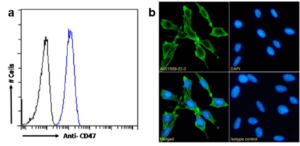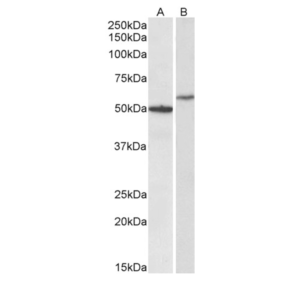Cancer cells exploit various immune checkpoints to evade immune recognition and destruction. They achieve this by, for example, upregulating the expression of molecules that inhibit the immune response, leading to uncontrolled growth and spread (Vinay et al., 2015). Therapeutic approaches such as anti-CD47 antibodies can be powerful tools to counteract these evasion mechanisms, enhancing the immune response against cancer (Nakamura & Smyth, 2020).
CD47 and the Immune System
A prominent example of such an evasion mechanism is the exploitation of a myeloid immune checkpoint by cancer cells that involves Cluster of Differentiation 47 (CD47). CD47 – also known as integrin-associated protein (IAP), MER6, and OA3 – is a transmembrane glycoprotein that is expressed on the surface of various cells and interacts with signal-regulatory protein alpha (SIRPα), a receptor expressed on myeloid cells such as macrophages (Zhao et al., 2022).
CD47 plays a crucial role in immune regulation and cell signaling – one of its primary functions is to signal “don’t eat me” to the immune system. When CD47 is on the cell’s surface, it binds to SIRPα, signaling macrophages not to engulf and destroy the cell, effectively protecting it from phagocytosis (Oronsky et al., 2020). While CD47 is expressed in various cells, including healthy cells, it is particularly relevant in cancer cells. CD47 is often overexpressed on the surface of cancer cells. Therefore, CD47 is an attractive target for cancer immunotherapy (Jiang et al., 2021; Yang et al., 2023).
Anti-CD47 Antibodies — an Emerging, Effective Immunotherapy in the Fight Against Cancer
Research using anti-CD47 antibodies dates back to the early 1990s. However, only recently have these antibodies started gaining traction as an effective tool against CD47-overexpressing cancer cells, with particular emphasis on treating hematologic malignancies.
Anti-CD47 antibodies have several potential uses. They can be used to investigate the role of CD47 in immune regulation and cancer immune evasion, to develop new CD47 targeting cancer immunotherapies (e.g., by blocking CD47-SIRPα interaction to enhance phagocytic activity against cancer cells), and to enhance the efficiency of existing therapies such as chemotherapy, radiation therapy, or other immune-checkpoint inhibitors like anti-PD-1 or anti-CTLA-4 antibodies (Huang et al., 2022; Maute et al., 2022). In preclinical studies and early-phase clinical trials, anti-CD47 antibodies have shown promising results as cancer immunotherapy both as a single agent and in combination with other cancer therapies (Sun et al., 2021; Zhao et al., 2022).
Absolute Antibody’s Recombinant VivopureX™ Antibodies
All of our antibodies are recombinantly produced to ensure batch-to-batch reproducibility. Furthermore, one of the available anti-CD47 clones — mIAP301 (Ab01569-3.3) — has been further engineered to better suit in vivo research in mice. This antibody is part of our VivopureX™ collection, consisting of clones engineered into mouse-anti-mouse recombinant versions to reduce immunogenicity in mouse models (Figure 1). This clone is also available as an anti-CD47 Fc Silent™ antibody for even more experimental opportunities. The Fc Silent™ format contains key point mutations that abrogate binding to Fc receptors, abolishing antibody-directed cytotoxicity effector function of Fc receptors.
The mIAP301 clone specifically binds to exon 2 of CD47’s extracellular domain that encodes both the predicted signal peptide cleavage site and the entire Ig domain. It has a wide range of uses, with cited applications including immunoprecipitation, Western blots, flow cytometry, immunofluorescence, and more. Examples of anti-mCD47 [mIAP301] in flow cytometry analysis and immunofluorescent imaging can be found in Figure 2.

Figure 2. (a) Flow cytometry of L929 cells and (b) immunofluorescence staining of paraformaldehyde-fixed L929 cells using mIAP301 (Ab01569).
Absolute Antibody’s Anti-CD47 Range of Products
In addition to our VivopureX™ CD47 antibody, we offer a wide range of other high-quality anti-CD47 antibodies ready for use in various applications (Table 1). Each antibody is available in one or more recombinant engineered formats to address the many experimental pathways researchers may take in studying CD47. Multiple antibody species options are available for most of our anti-CD47 antibodies, and many clones include Fc Silent™ formats so researchers can control for Fc region binding. For more information on each of our anti-CD47 offerings, see the table below and each product’s page for characterization data.
If your research requires a two-prong approach to CD47, our anti-mCD47 nanobody A4 has been used in the construction of a range of murine bispecific molecules, ideal for evaluating potential bispecific combinations in mouse models. Anti-CD47 bispecifics are available off-the-shelf in conjunction with anti-FITC/fluorescein, anti-TRP-1, anti-mCD200, anti-mPD-1, and anti-mPD-L1. Some of these bispecific molecules also include engineering to abrogate Fc region binding and minimize ADCC and CDC. Take a look at our mouse bispecific antibody offerings and multispecific custom services to see how our antibody engineers can help solve your unique experimental problems.
As a scientist in the field of cancer therapy, you are already doing meaningful work that has the potential to change lives. But with the recent advancements in the development of anti-CD47 antibodies, you have the opportunity to take your research and therapeutic solutions to the next level. With our extensive range of high-quality antibodies, including those specific to CD47, you will have access to the tools you need to conduct groundbreaking research or offer the best therapeutic solutions in cancer therapy. Whether you need monoclonal antibodies, recombinant proteins, or custom antibody services, we have everything you could need to advance your research.
Interested in our available anti-CD47 antibodies or other formats? We can offer our antibodies in custom formats per demand. Please contact us for more information.

Figure 3. EB12501 (0.3µg/ml) staining of Human Hippocampus (A) and HeLa (B) lysates (35µg protein in RIPA buffer). Primary incubation was 1 hour. Detected by chemiluminescence.
Related Reagents from Our Sister Company
Absolute Antibody is just one of the industry-leading brands under the Absolute Biotech banner. Everest Biotech, our sister company, specializes in high-quality goat polyclonal antibodies and offers a polyclonal antibody that recognizes CD47 in human tissues. Figure 3 is a western blot that illustrates this antibody’s staining in human hippocampus and HeLa lysates.
If you are working with human tissues and cells, benefit from the specific high affinity and sensitivity for different epitopes within the same sample that polyclonal antibodies provide. Each Everest antibody is rigorously tested by a team of QC scientists to ensure batch-to-batch consistency, so you can have confidence in the performance of your antibodies. Visit Everestbiotech.com for more information on Everest’s polyclonal antibodies.
| Antibody ID | Clone | Epitope/Specificity | Published Applications | Published Species Reactivity | Available Formats |
|---|---|---|---|---|---|
| Ab00570 | OX-101 | CD47 | IP, WB, Block, FC | Rat | Mouse IgG1 |
| Ab00738 | mIAP430 | CD47 | Blocking, IF | Human | Rabbit IgG Rat IgG2a Rat IgG2a, Fc Silent™ Human IgG1 Human IgG1, Fc Silent™ |
| Ab01061 | A4 | murine CD47 | Antagonist, blocking, functional assays, in vitro, in vivo, FC | Mouse | Rabbit IgG-Fc fusion Rabbit IgG-Fc fusion, His-Tagged Mouse IgG1-Fc fusion |
| Ab01468 | C5D5 | human CD47 | Functional inhibition, IP, ELISA, FC, IF | Human | Rabbit IgG Mouse IgG2b Mouse IgG2b, Fc Silent™ Human IgG1 Human IgG1, Fc Silent™ |
| Ab01521 | CF 9D7 | CD47 | N/A | Human | Rabbit IgG Mouse IgG2c Mouse IgG2c, Fc Silent™ Human IgG1 Human IgG1, Fc Silent™ |
| Ab01569 | mIAP301 | CD47 extracellular domain | IP, WB, Block, FC, IF | Mouse | Rabbit IgG Rat IgG2a Rat IgG2a, Fc Silent™ Mouse IgG2b Mouse IgG2b, Fc Silent™ (VivopureX) |
| Ab03102 | 2D14 | Human CD47 extracellular domain | ELISA, FC | Human | Rabbit IgG Mouse IgG1 Mouse IgG1, Fc Silent™ Human IgG1 Human IgG1, Fc Silent™ |
| Ab03103 | ZF1 | Human CD47 extracellular domain | Block, ELISA, FC | Human | Rabbit IgG Human IgG1 Human IgG1, Fc Silent™ Mouse IgG2b Mouse IgG2b, Fc Silent™ |
| Ab03104 | h4C1 | Human CD47 FG loop | Block, ELISA, FC | Human | Rabbit IgG Mouse IgG2a Mouse IgG2a, Fc Silent™ Human IgG1 Human IgG1, Fc Silent™ |
| Ab03105 | B6H12 | Human CD47 extracellular domain | IP, Block, ELISA, FC | Human | Rabbit IgG Human IgG1 Human IgG1, Fc Silent™ Mouse IgG1 |
| Ab03167 | C47B227 | CD47 | Crystallography, inhibition | Human | Rabbit IgG Mouse IgG1 Mouse Fab fragment, His-Tagged |
| Ab03774 | AbAbCD47 | Human CD47 extracellular domain | ELISA | Human | N/A |
| Ab03775 | CD47Nb | Human CD47 extracellular domain | Block, FC | Human, Cynomolgus Monkey | N/A |
| Ab03948 | 105D11 | Human CD47 extracellular domain | Block, ELISA, FC | Human, Cynomolgus Monkey | Rabbit IgG Human IgG1 Human IgG1, Fc Silent™ Mouse IgG1 |
| Ab03949 | VHH1 | CD47 & CD70 (bispecific) | ELISA | Human | N/A |
Latest News
Upcoming Events
Please join us at the following conferences and events. Stop by our booth, or get in touch to arrange a meeting.
See All Dates
 United Kingdom (UK)
United Kingdom (UK) 